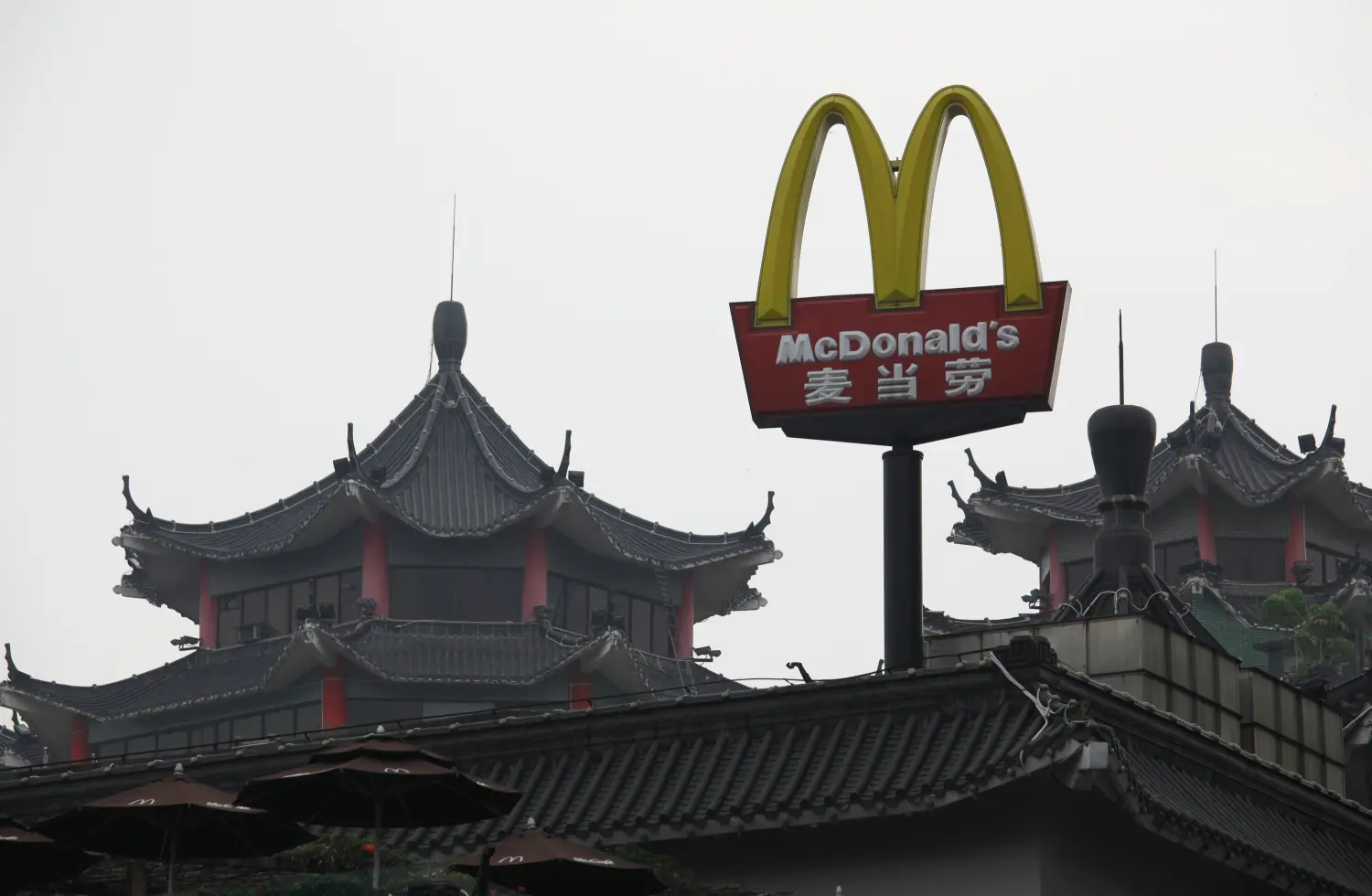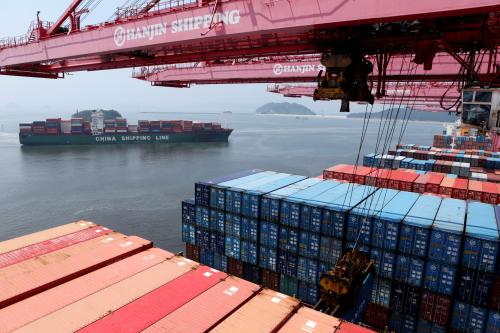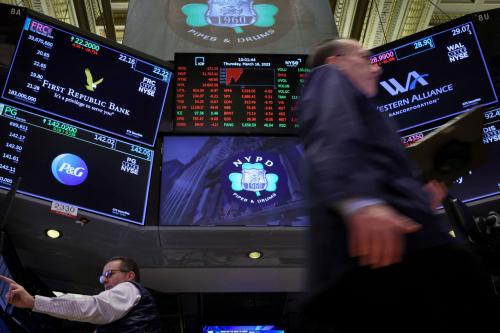The following brief is part of Brookings Big Ideas for America—an institution-wide initiative in which Brookings scholars have identified the biggest issues facing the country and provide ideas for how to address them. (Updated January 23, 2017)
China in the past few decades has emerged as the world’s largest exporter and the United States’ second-largest trading partner after Canada. Despite being a relatively poor developing country, China has built up the largest trade surpluses in human history, creating economic problems for the United States. Trade with China has led to the loss of American manufacturing jobs, reduced real wages for semiskilled workers, and devastated some communities dependent on low-end manufacturing jobs. These negative effects have naturally given rise to protectionist sentiments in the U.S. presidential campaign and given trade in general a bad name.
While protectionism is tempting, it is almost certain to backfire and cause more economic harm to the United States. Inducing China to become a more normal trading and investing nation will require a mix of carrots and sticks from the next administration, a policy that could be characterized as “responsible hardball.” As a departure from current policy, the most promising option would be imposing new restrictions on Chinese state enterprises purchasing their competitors in the United States until China opens up reciprocally. The United States can also use leverage over China’s desire to be granted market economy status in order to negotiate significant reductions in excess capacity in steel and other heavy industries.
BACKGROUND
Economists generally agree that trade between the United States and China has had negative effects on U.S. manufacturing employment, though estimates of the impact vary. What is not in dispute is that U.S. manufacturing employment declined sharply in the 2000s, dropping from 17 million in 2000 to 11 million in 2010. Some have estimated that China’s reform and opening up explained 25 percent of the decline in American manufacturing jobs between 1991 and 2007, and 40 percent of the loss after 2000.1 Others emphasize that the U.S. trade deficit was already large in 2000, and that trade accounted for little of the job loss in the 2000s. However, most agree that if the U.S. trade deficit were eliminated completely—a big “if”—then U.S. manufacturing employment would be 25 percent higher (3 million more jobs on the current base).2
The United States had problems earlier with large trade surpluses in Asian partners such as Japan, South Korea, and Taiwan. China was different from these three economies in at least three ways. First, China’s trade surpluses emerged at an earlier stage of development than in the other Asian economies. China was still a relatively poor, capital-scarce economy when it started running trade surpluses. Second, China has a much bigger population than its East Asian neighbors, making it a greater challenge for the world to absorb Chinese surpluses. Third, the Chinese economy is a complex hybrid of private entrepreneurship on the one hand and a large state enterprise and government sector on the other. A trade surplus reflects an excess of savings over investment. China has had a lot of economic distortions that have tended to keep both savings and investment high, but savings in particular has been especially high. In recent years, China is a complete outlier among major economies, with a national savings rate near 50 percent of GDP.
One of the key distortions in the economy has been management of the exchange rate. In 1994, China pegged its currency, the yuan, to the U.S. dollar at a rate of 8.3:1. This was a reasonable and not unusual choice for a developing economy. At that rate, the trade balance was close to zero for the first few years, making it hard to argue against that level. The problem is that China had rapid productivity growth that required some appreciation over time. China was becoming competitive in more and more goods, but it resisted adjustment of the exchange rate. It was at this point that China developed a very large trade surplus that rose above 10 percent of GDP. Pegging the currency to the dollar in the face of a large trade surplus requires the central bank to accumulate reserves, and China’s reserves over this period rose to a global high of $4 trillion.
For many years, Chinese state-owned enterprises (SOEs) largely deployed the savings in-country. But now, with problems of excess capacity emerging in many sectors, SOEs have turned outward and are on a global buying spree.
Currency manipulation was one important distortion in the Chinese economy, but not the only one. China still has a large state-enterprise sector that earns profits but effectively pays no dividends to anyone. If firms were owned by households, then some of the profits would end up stimulating consumption; but in China those profits all end up as savings. For many years, Chinese state-owned enterprises (SOEs) largely deployed the savings in-country. But now, with problems of excess capacity emerging in many sectors, SOEs have turned outward and are on a global buying spree.
These economic factors create a new set of problems for the United States and other advanced economies. First is the issue of the trade surplus. China shifted off the peg to the dollar in 2005, and over the past decade it has allowed its currency to appreciate significantly—about 20 percent against the dollar since 2005. As a result of this new currency policy, China stopped intervening in the foreign exchange market to accumulate reserves. In fact, since 2015 China has been selling reserves to keep the value of its currency high, and its $4 trillion reserves stockpile has declined to $3.1 trillion. In the face of this new currency policy, China’s trade surplus initially declined. But now it has started to rise again, and one factor is the shift of SOE investment outward. There are also net private outflows of capital, though it is hard to measure these exactly. The growing net capital outflow from China is threatening to take China’s trade surplus back to levels that pose problems for the global economy.
A second and related problem is that China’s policy toward foreign direct investment is highly asymmetric. China is now encouraging its firms to invest abroad in virtually all sectors. Meanwhile, according to an Organization for Economic Cooperation and Development measure of investment restrictiveness, China is the most closed of major economies. It is significantly less open than other emerging markets such as Brazil, India, Mexico, or South Africa.3 China is partially open in manufacturing, though important sectors such as motor vehicles have to operate through awkward 50-50 joint ventures that force global auto companies to pair with local partners. Most of the modern services sectors such as finance, telecommunications, media, and logistics are almost completely closed to foreign investment. Even in sectors that are ostensibly open, U.S. firms are often reluctant to invest in China because their intellectual property rights, as well as property rights more generally, are poorly protected. This creates an unlevel playing field in which Chinese firms can earn profits in a protected market at home and then buy their competitors in the United States and Europe. The interagency Committee on Foreign Investment in the United States (CFIUS) can review mergers and acquisitions for their national security implications, but there are relatively few transactions that can be legitimately stopped on those grounds. In recent years, the review process has approved Chinese purchases of Smithfield Foods (a U.S. pork production enterprise) and Syngenta (a Swiss agricultural chemical company with large U.S. operations).
China’s policy towards foreign direct investment is highly asymmetric.
In addition to trade with China, America’s trade with other partners also has been called into question during the current election season. In particular, the North American Free Trade Agreement (NAFTA) has been castigated for costing U.S. manufacturing jobs—however, there is little evidence that NAFTA had this particular effect. The nonpartisan Congressional Research Service, in its study “NAFTA at 20,” concluded that “NAFTA did not cause the huge job losses feared by the critics or the large economic gains predicted by supporters. The net overall effect of NAFTA on the U.S. economy appears to have been relatively modest.”4 NAFTA, unfortunately, was largely being implemented at the same time that China was entering the global economy, and effects on the U.S. economy from China trade were misattributed to NAFTA.
One reason that it is hard to find any net negative job effects of NAFTA is that trade between the United States on the one hand and Canada and Mexico on the other has been relatively balanced. The same point holds for the group of economies that have negotiated the Trans-Pacific Partnership (TPP). This group includes Canada and Mexico, as well as Japan and a total of 12 Asia-Pacific economies. China is not included. In 2014, the United States imported $750 billion of goods from these partners and exported a similar amount, $726 billion. In the same year, the United States imported $467 billion in goods from China, but exported only $124 billion. On average, TPP partners are also more open to investment than China’s economy. At the end of 2014, the United States had more than $1 trillion of foreign investment stock in the TPP partners, 15 times more than its paltry $67 billion of investment in China.
A final important piece of background is that the growth of the U.S. economy slowed significantly between the 1990s and the 2000s. It would be hard to attribute any significant part of the slowdown to China. The large trade gap with China may be annoying, but it is still small compared with the overall U.S. economy. For example, the $467 billion of imports in 2014 represented less than 3 percent of the U.S. economy. The slowdown in U.S. growth can be attributed to a multitude of factors, including the aging population, underinvestment in education and infrastructure, and the 2007–9 financial crisis. And although the share of manufacturing in employment has been on a slow but steady decline since the 1950s, the share of manufacturing in GDP has been stable.5 This pattern reflects the relatively faster productivity growth in manufacturing compared to services. What distinguishes the 2000s from the 1990s is that overall employment growth has been so slow. In thinking about how to deal with China, there is a risk that that issue will distract from more important considerations about how to make U.S. output and employment grow more quickly.
POLICY OPTIONS FOR U.S.-CHINA TRADE AND INVESTMENT
The next president will want to shape a policy of “responsible hardball” with China. Hardball, because China needs incentives to open up to the standards of other large emerging markets, and responsible, because there are real risks that trade and investment restrictions will be either ineffective or counterproductive.
Restrictions on SOE investments
The new imbalance in the relationship is that Chinese state enterprises are buying their competitors in the United States and Europe, especially in high-tech sectors. U.S. firms are not allowed to make similar purchases in China because of China’s restrictions. The CFIUS review process, by statute, is focused narrowly on national security issues, not on broader issues of national interest or economic fairness. The United States and China have been negotiating a Bilateral Investment Treaty, and for this treaty to be in the U.S. interest—not to mention for it to have any chance of being passed in Congress—it should require China to open up virtually all of its economy to foreign investment. Interestingly, President Xi Jinping’s administration has prioritized this negotiation, but there is a lot of resistance from state enterprises and different parts of the government bureaucracy.
The next administration should consider legislation that restricts the ability of foreign state enterprises to invest in the United States, especially through mergers and acquisitions. It would be reasonable to have some exceptions, such as investments from countries with which the United States has investment agreements. This could be crafted to provide incentives for China to reach an investment agreement with the United States. Given that investment negotiations could drag on for years, it would also provide sensible protections for U.S. firms in the meantime.
Trade war with China
As a presidential candidate, Donald Trump proposed a 45 percent tariff on imports from China. This idea is likely to backfire. Chinese leaders would definitely not buckle under such pressure. For one, exports to the United States are not that important to the Chinese economy anymore, and China’s leaders have many avenues to keep its economy growing. For another, China’s authoritarian leaders could not buckle to U.S. pressure without risking their hold on power. The population is nationalistic, and its attitude toward the United States is quite ambivalent. A direct trade attack on China would certainly whip up popular support for retaliation. The retaliation would not have much direct effect on the U.S. economy, since the United States exports so little to China, but it would create an uncertain environment for trade and investment globally that would slow U.S. growth.
Trade remedies
While all-out trade war with China is not a good idea, the United States does have tools that it can deploy to address China’s World Trade Organization (WTO) violations, as well as dumping or import surges that violate U.S. trade laws. The Obama administration has brought more WTO cases against China than its predecessors, and has used trade remedies more often as well. These actions are sensible, but in general China is following WTO rules, which do not set a very high standard. The distortions in China noted above— such as restricting foreign investment or maintaining a large state-enterprise sector—are not covered by WTO disciplines at all.
Still, using trade remedies is an important part of U.S. trade policy. One practical issue at the moment concerns China’s status as a nonmarket economy. When China joined the WTO in 2001, it agreed that it could be treated as a nonmarket economy for up to 15 years. The practical import is that in antidumping cases, the United States can look at costs in similar economies (such as Brazil) in determining whether Chinese exporters are selling below cost. The 15-year term ended in December, and China is expecting to receive market economy status at this time—in fact, it may bring a WTO case against the United States if it does not. U.S. law has a definition of a market economy; although this definition is somewhat subjective, a good case can be made that China does not meet the standard. In the current political environment, it is impossible to imagine that Congress would vote in favor of giving China market economy status.
Antidumping procedures are very relevant at the moment, because China has developed extremely large excess capacity in steel and other heavy sectors. The next administration should use market economy status as a bargaining chip to negotiate specific reductions in excess capacity, especially in steel. China would have a good case in the WTO if it chose that route, but a WTO case would take years and China is likely to prefer a negotiated settlement.
TPP as an incentive
The main value of the (TPP) agreement in fact is strategic. Asia-Pacific partners are looking for U.S. leadership in maintaining and extending an open trading system with fair rules.
It is ironic that China has given trade a bad name and that the negativity has spilled over to feelings about the TPP. As detailed in “The Trans-Pacific Partnership: The Politics of Openness and Leadership in the Asia-Pacific,” the TPP is a gold standard agreement among like-minded countries with which the United States has relatively balanced trade, including both advanced economies and developing ones such as Vietnam, Mexico, and Peru.6 Because these are relatively open economies, the economic benefits of further opening are modest. By the same token, any adjustment costs in the United States are likely to be small. The main value of the agreement in fact is strategic. Asia-Pacific partners are looking for U.S. leadership in maintaining and extending an open trading system with fair rules. China is not one of the negotiating countries, and it would be hard for China to meet TPP standards because these standards would require China to open up its trade and investment and to adjust other regulations. We should hold out hope that China will one day aspire to meet these standards and join the TPP, but we should not hold our breath about China’s system changing quickly. If the TPP is implemented, South Korea and ASEAN members could be attracted to join. It has the potential to spur new supply chains among a group of countries that have to some extent harmonized their regulations on investment, environmental protection, and labor standards. The TPP could be a positive incentive for China to reform, but if the United States turns its back on the agreement, Asian economies will naturally adjust to a world in which the United States retreats from Asia and China rises as the economic power in the region.
If the United States turns its back on the agreement, Asian economies will naturally adjust to a world in which the United States retreats from Asia and China rises as the economic power in the region.
Name China as a currency manipulator
This option is truly fighting the last war. In 2015, Congress wrote a formal definition of a currency manipulator: at its heart is the criterion that the country in question is intervening in the currency market accumulating foreign reserves. For much of the past decade, China would have met this particular criterion. But for at least a year now, China has been selling reserves to keep the value of its currency high, not low. It is hard to find economists or investors who think that that situation might turn around. To the contrary, there are plenty of investors betting that China will not be able to prevent the market from depreciating its currency. The underlying problem is the enormous savings rate in China. With diminishing investment opportunities, a vast amount of capital is trying to get out of the country. At this point, it is a mistake to focus any dialogue with China on the currency market; we should in fact be happy that China is intervening to keep its currency high, since a large Chinese depreciation would likely destabilize global financial markets. Just the hint of significant devaluation in August 2015 and again in December sent financial markets tumbling.
Focus the economic dialogue with China on the distortions that keep the savings rate high
The United States has a range of government-to-government dialogues with China. The most prominent, the Strategic and Economic Dialogue, has become too big and formal to be of much use. But certainly the United States will continue various dialogues at different levels. It makes sense to separate the economic dialogue from the strategic issues and to focus the economic dialogue on the distortions in China that keep the savings rate high—this is the fundamental problem behind China’s large and growing trade surplus.
Adjustment assistance
If China were to open up and reform, there would be many more export opportunities for U.S. firms and workers and more balanced trade between the world’s two biggest economies. Still, there will be winners and losers on each side. Expanded trade with China on a balanced basis would create a lot of jobs in the United States, but would lead to job losses in some sectors. The United States has done a poor job providing retraining and other support to workers and communities hurt by trade (or by technological change, which is actually more common). To get the maximum benefit from trade and to maintain popular support for it, we need more extensive and effective adjustment assistance in the United States.
-
Footnotes
- David H. Autor, David Dorn, and Gordon H. Hanson, “The China Shock: Learning from Labor Market Adjustment to Large Changes in Trade,” Working Paper 21906 (Cambridge, Mass.: National Bureau of Economic Research, January 2016), www.nber.org/papers/w21906.
- Lawrence Edwards and Robert Z. Lawrence, Rising Tide: Is Growth in Emerging Economies Good for the United States? (Washington, D.C.: Peterson Institute for International Economics, 2013).
- David Dollar, “China as a Global Investor” (Brookings, May 2016).
- M. Angeles Villareal and Ian F. Fergusson, “NAFTA at 20: Overview and Trade Effects” (Congressional Research Service, April 2014), http://digitalcommons.ilr.cornell.edu/key_workplace/1261/.
- Martin Baily and Barry Bosworth, “U.S. Manufacturing: Understanding Its Past and Potential Future,” Journal of Economic Perspectives 28, no. 1 (Winter 2014): 3–26.
- Mireya Solís, “The Trans-Pacific Partnership: The Politics of Openness and Leadership in the Asia-Pacific” (Brookings, October 2016).










